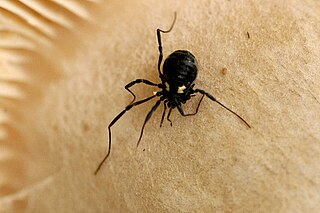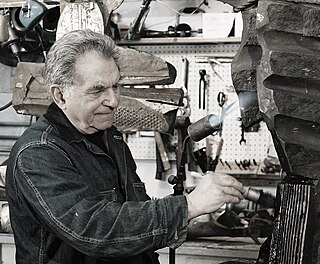
The Phalangiidae are a family of harvestmen with about 380 known species. The best known is Phalangium opilio. Dicranopalpus ramosus is an invasive species in Europe.

The Nemastomatidae are a family of harvestmen with about 170 described species in 16 recent genera. Several fossil species and genera are known.

Hadži-Prodan's rebellion was a Serbian rebellion against the Ottoman Empire, which took place from 27 September to 30 December 1814. It occurred between the First (1804–13) and Second (1815–17) uprisings of the Serbian Revolution.

Jovan Hadži was a Slovenian zoologist of Serbian origin.
Halofolliculina corallasia is a species of heterotrich ciliates identified as a cause of the syndrome called skeletal eroding band (SEB). It is the first coral disease pathogen that is a protozoan as well as the first known to be a eukaryote; all others identified are bacteria. Like other members of the folliculinid family, H. corallasia is sessile and lives in a "house" called a lorica, into which the cell can retreat when disturbed. The mouth is flanked by a pair of wing-like projections that are fringed with polykinetids, groups of cilia that work in groups to produce a current that draws food into the "mouth".
Elpida Hadzi-Vasileva is a site specific installation artist who works across sculpture, installation, and architectural interventions.

Prodan Gligorijević, known simply as Hadži-Prodan was a Serbian voivode in the First Serbian Uprising of the Serbian Revolution, then the Greek War of Independence, against the Ottoman Empire. He led an unsuccessful rebellion in 1814, dubbed Hadži Prodan's Revolt.

Dimitri Hadzi was an American abstract sculptor who lived and worked in Rome, Italy for 25 years and later resided in Cambridge, Massachusetts, where he also taught at Harvard University for over a decade.

The Hadži-Prodan's Cave is an archaeological site of the Paleolithic period and a national natural monument, located in the village Raščići around 7 km (4.3 mi) from Ivanjica in western central Serbia. The rather narrow and high entrance with at an altitude of 630 m (2,070 ft) above sea level sits about 40 m (130 ft) above the Rašćanska river valley bed and is oriented towards the south. The 345 m (1,132 ft) long cave was formed during the Late Cretaceous in "thick-bedded to massive" Senonian limestone. Prehistoric pottery shards and Pleistocene faunal fossils had already been collected by Zoran Vučićević from Ivanjica. Animal fossils especially Cave bear and Iron Age artifact discoveries during an unrelated areal survey were reportedly made at the cave entrance and in the main cavern. The site is named in honor of Hadži-Prodan, a 19th century Serbian revolutionary.
Hadži-Zaharija was Metropolitan of Raška and Prizren from 1819 to 1830.

River Legend is an outdoor 1976 basalt sculpture by American artist Dimitri Hadzi, located outside of the Edith Green – Wendell Wyatt Federal Building in Portland, Oregon.

Jovan Hadži-Vasiljević was a Serbian historian, ethnographer, journalist and writer.
Spiro Crne was a rebel leader active in Ottoman Macedonia. Born in a village near Prilep, he killed an Ottoman tyrant and fled to Serbia, in the north. In Vranje, he established a rebel band trained and armed by the Serbian military government that was sent into Macedonia.

Hadži-Ruvim, born Rafailo Nenadović, was a Serbian Orthodox archimandrite of the Bogovađa Monastery, near Lajkovac, an artist and engraver, who was part of a plot to overthrow the Dahije, renegade Janissaries that had taken control of the Sanjak of Smederevo. He was jailed and later killed in the event known as the Slaughter of the Knezes. Hadži-Ruvim was an artist, wood carver, engraver and book collector. His most beautiful engraved cross was the one for Čokešina Monastery dating from 1799. He left notes and drawings on empty pages at the monasteries he visited. In Mionica, 92 kilometers from Belgrade, there's a church famous for the icons belonging to the Hadzi-Ruvim Art School.
Marko Vasić, known as Kara-Marko (Кара-Марко) was a Serbian Revolutionary
The Pirot rebellion broke out in the town Pirot in Ottoman Bulgaria after the Orthodox Christian population in the area suffered oppression by the local Ottoman leader and Orthodox bishop. Refugees across the border in Serbia planned the rebellion and rose up together with villagers from the area during a scheduled meeting of the two sides agreed upon by the Serbian Prince Miloš Obrenović, the community protector, and the Vali of Rumelia. He had promised to help the rebels, but broke out his promise and remained loyal to the Ottoman Sultan. The Serbian prince suppressed the rebels and punished the fugitives.
Events in the year 2019 in Slovenia.

Thermopylae is a 1966 bronze sculpture by Dimitri Hadzi, installed at Boston City Hall Plaza near the John F. Kennedy Federal Building, in Boston's Government Center, in the U.S. state of Massachusetts.










